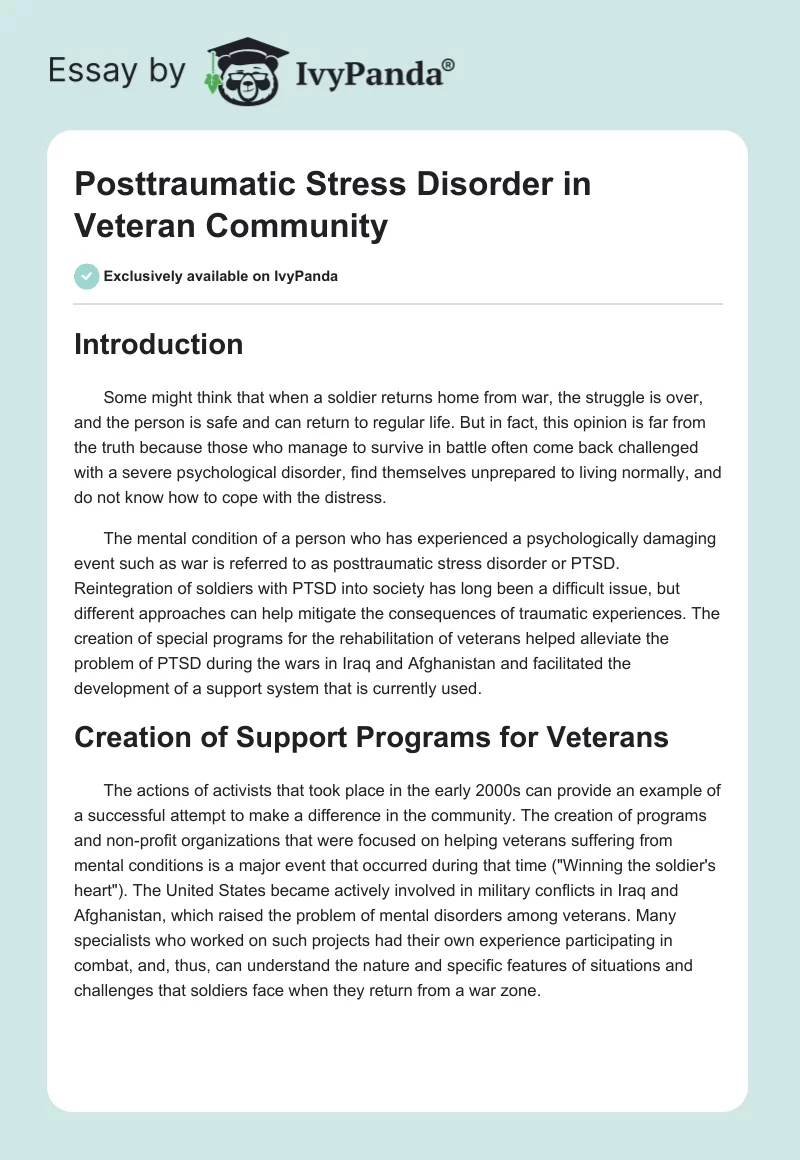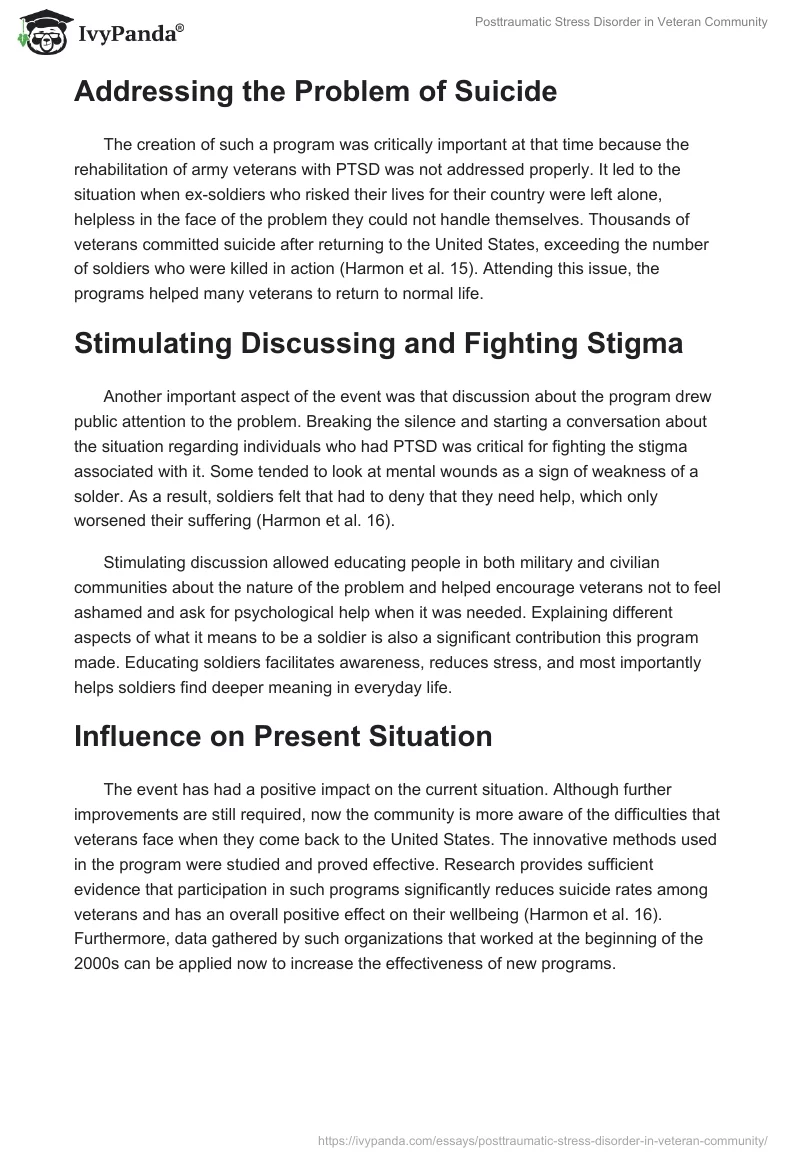Introduction
Some might think that when a soldier returns home from war, the struggle is over, and the person is safe and can return to regular life. But in fact, this opinion is far from the truth because those who manage to survive in battle often come back challenged with a severe psychological disorder, find themselves unprepared to living normally, and do not know how to cope with the distress.
The mental condition of a person who has experienced a psychologically damaging event such as war is referred to as posttraumatic stress disorder or PTSD. Reintegration of soldiers with PTSD into society has long been a difficult issue, but different approaches can help mitigate the consequences of traumatic experiences. The creation of special programs for the rehabilitation of veterans helped alleviate the problem of PTSD during the wars in Iraq and Afghanistan and facilitated the development of a support system that is currently used.
Creation of Support Programs for Veterans
The actions of activists that took place in the early 2000s can provide an example of a successful attempt to make a difference in the community. The creation of programs and non-profit organizations that were focused on helping veterans suffering from mental conditions is a major event that occurred during that time (“Winning the soldier’s heart”). The United States became actively involved in military conflicts in Iraq and Afghanistan, which raised the problem of mental disorders among veterans. Many specialists who worked on such projects had their own experience participating in combat, and, thus, can understand the nature and specific features of situations and challenges that soldiers face when they return from a war zone.
Addressing the Problem of Suicide
The creation of such a program was critically important at that time because the rehabilitation of army veterans with PTSD was not addressed properly. It led to the situation when ex-soldiers who risked their lives for their country were left alone, helpless in the face of the problem they could not handle themselves. Thousands of veterans committed suicide after returning to the United States, exceeding the number of soldiers who were killed in action (Harmon et al. 15). Attending this issue, the programs helped many veterans to return to normal life.
Stimulating Discussing and Fighting Stigma
Another important aspect of the event was that discussion about the program drew public attention to the problem. Breaking the silence and starting a conversation about the situation regarding individuals who had PTSD was critical for fighting the stigma associated with it. Some tended to look at mental wounds as a sign of weakness of a solder. As a result, soldiers felt that had to deny that they need help, which only worsened their suffering (Harmon et al. 16).
Stimulating discussion allowed educating people in both military and civilian communities about the nature of the problem and helped encourage veterans not to feel ashamed and ask for psychological help when it was needed. Explaining different aspects of what it means to be a soldier is also a significant contribution this program made. Educating soldiers facilitates awareness, reduces stress, and most importantly helps soldiers find deeper meaning in everyday life.
Influence on Present Situation
The event has had a positive impact on the current situation. Although further improvements are still required, now the community is more aware of the difficulties that veterans face when they come back to the United States. The innovative methods used in the program were studied and proved effective. Research provides sufficient evidence that participation in such programs significantly reduces suicide rates among veterans and has an overall positive effect on their wellbeing (Harmon et al. 16). Furthermore, data gathered by such organizations that worked at the beginning of the 2000s can be applied now to increase the effectiveness of new programs.
Future of the Problem
Based on how the situation has been developing over the last decades, the prognosis for the future can be quite optimistic. The development of new ways to approach PTSD that are both effective and inexpensive will provide everyone who needs help with appropriate treatment and support. Evidence-based methods and techniques will be further improved, and the number of professionals who specialize in the field will increase, leading to a higher quality of help. In addition to that, growing public awareness of the situation and efforts in education will facilitate the process of reintegration of veterans into society. Educating the public will also help avoid stigmatization and alienation of the affected individuals in the community, allowing faster and easier recovery.
Conclusion
Understanding the challenges of others, helping them to feel respected and accepted, and fighting stigma are necessary to promote diversity in society and create a better world for everyone. Non-profit organizations and programs that were created in the early 2000s and provided psychological help and support for veterans with PTSD and other challenging conditions showed that the problem could be addressed and lightened. Stimulating conversation, turning public attention to the issue, and educating people have led to a better understanding of the situation and helped dispel misconceptions and stigma regarding it.
Works Cited
Harmon, Lisa M., et al. “A Review of the Effectiveness of Military Suicide Prevention Programs in Reducing Rates of Military Suicides.” Journal of Human Behavior in the Social Environment 26.1 (2016): 15-24.
“Winning the Soldier’s Heart.” Washington Post, 2009. Web.


